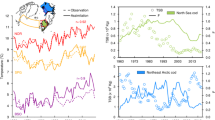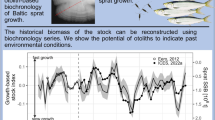Abstract
The methods presently in wide use for the assessment of marine ecosystems and fish stocks cannot provide the high-quality long-term prognoses urgently needed for improved management of marine ecosystems and their fishery resources. A novel method of forecasting the long-term qualitative composition of ecosystem and fish stocks in the Baltic Sea based on the periodicity and succession of the processes: extraterrestrial factors → climate changes → regime forming factors (chiefly salinity and temperature) → ecosystems → fish stocks was used in 1989 to predict the approximate year class abundances of cod (Gadus morhua callarias), sprat (Sprattus sprattus balticus), sea herring and gulf herring (Clupea harengus membras) in the Baltic Sea for the years 1989–2008. A comparison with actual development up to 2008 show that this prognosis was confirmed to a considerable extent. The method based on periodical fluctuations of freshwater input and the thermal regime is described. It predicts a new regime shift in the 2020s to a higher salinity and more acceptable conditions for the organisms of marine origin.




Similar content being viewed by others
References
Alheit J, Möllmann C, Dutz J, Kornilovs G, Loewe P, Mohrholz V, Wasmund N (2005) Synchronous ecological regime shifts in the central Baltic and the North Sea in the late 1980 s. ICES J Mar Sci 62:1205–1215
Aro E (2000) The spatial and temporal distribution patterns of cod (Gadus morhua callarias L.) in the Baltic Sea and their dependence on environmental variability—implications for fishery management. Dissertation, University of Helsinki
Bagge O, Thurow F, Steffensen E, Bay E (1994) The Baltic cod. Dana 10:2–228
Beddington JR, Agnew DJ, Clark CW (2007) Current problems in the management of marine fisheries. Science 316:1713–1716
Bergstöm L, Diekmann R, Flinkman J, Gardmark A, Kornilovs G, Lindegren M, Müller-Karulis B, Möllmann C, Plikshs M, Põllumäe A (2010) Integrated ecosystem assessments of seven Baltic areas covering the last three decades. In: Diekmann R, Möllmann C (eds) ICES Coop Res Rep No 302. p 90
Bergström S, Carlsson B (1994) River runoff to the Baltic Sea: 1950–1990. Ambio 23:280–287
Biester E (1979) Die Frühjahrshering Rügens—seine Rolle in der Fischerei der Ostsee und in den Übergangsgebieten zur Nordsee, Rostock
Binet D (1988) French sardine and herring fisheries: a tentative description of their fluctuations since the eighteenth century. In: Wyatt T, Larraneta MG (eds) Long term changes in marine fish populations. Vigo, pp 253–272
Bulletin Hydrographique (1921–1959) Copenhagen
Drinkwater KF (2006) The regime shift in the 1920s and 1930s in the North Atlantic. Progr Oceanogr 68:134–151
Eero M, MacKenzie BR, Karlsdottir HM, Gaumiga R (2007) Development of international fisheries for the eastern Baltic cod (Gadus morhua) from the late 1880 s until 1938. Fish Res 87:155–166
Elwertowski J (1957) Biologiczna charakterystyka polskich połowow szprota w Baltyku południowym w latach 1950–1954. Rep Sea Fish Inst Gdynia 9:175–219
Fonselius S (1969) Hydrography of the Baltic deep basins III. Ser. Hydrography, Rep 23. Fish Bd Sweden, Lund
Francis RC, Hare SR, Hollowed AB, Wooster WS (1998) Effects of interdecadal climate variability on the oceanic ecosystems of the NE Pacific. Fish Oceanogr 7:1–21
Fréon P, Mullon C, Voisin B (2003) Investigating remote synchronous patterns in fisheries. Fish Oceanogr 12:443–457
Greene CH, Pershing AJ (2007) Climate drives sea change. Science 315:1084–1085
Hagen E, Feistel R (2005) Climate turning points and regime shifts in the Baltic Sea region: the Baltic winter index (WIBIX) 1659–2002. Boreal Environ Res 10:211–224
Hela I (1966a) Fluctuations in the degree of continentality of Northern Europe in 1866–1965. Geophysics 8:331–334
Hela I (1966b) Secular changes in the salinity of the upper water layers of the northern Baltic Sea. Soc Sci Fenn 31:2–21
HELCOM (2002) Fourth periodic assessment of the state of the marine environment in the Baltic Sea area, 1994–1998. In: Baltic Sea Environment Proceedings 82B, Baltic Marine Environ Prot Comm
HELCOM (2007) HELCOM thematic assessment in 2007. Climate change in the Baltic Sea Area. In: Baltic Sea Environment Proceedings 111
Hydrological Yearbooks (1945–1992) Gidrometeoizdat, Leningrad
ICES (2000) The status of fisheries and related environment of northern seas. A report prepared for the Nordic Council of Ministers by ICES. Nord 2000:10
ICES (2009) Report of the ICES/HELCOM Working Group on Integrated Assessment of the Baltic Sea (WGIAB), 16–20 Mar 2009, Rostock, Germany. ICES CM 2009/BCC:02
ICES (2010a) Report of the ICES Advisory Committee 2010. Book 8, Baltic Sea. ICES Advice 2010
ICES (2010b) Report of the ICES/HELCOM Working Group on Integrated Assessments of the Baltic Sea (WGIAB), 19–23 Apr 2010, ICES Headquarters, Copenhagen, Denmark. ICES CM 2010/SSGRSP:02
ICES (2011) Report of the ICES/HELCOM Working Group on Integrated Assessment of the Baltic Sea (WGIAB), 4–8 Apr 2011, Mallorca, Spain. ICES CM 2011/SSGRSP.03
Kalejs M, Ojaveer E (1989) Long-term fluctuations in environmental conditions and fish stocks in the Baltic. Rapp P–v Réun Cons Int Explor Mer 190:153–158
Klinkhardt M (1984) Untersuchungen zur Embryonalphase des Laiches Rügenscher Frühjahrsheringe unter besonderer Berücksichtigung natürlicher Mortalitätsraten auf einem ausgewählten Laichplatz des Greifswalder Boddens. Dissertation, Wilhelm-Pieck-Universität Rostock
Köster FW, Möllmann C, Neuenfeldt S, Vinther M, John MA, Tomkiewicz J, Voss R, Hinrichsen HH, Kraus G, Schnack D (2003) Fish stock development in the Central Baltic Sea (1976–2000) in relation to variability in the physical environment. ICES Mar Sci Symp 219:294–306
Lablaika IA, Uzars DV (1967) Stock condition and distribution of cod in 1965 and the prospects of its exploitationin the central Baltic in1967–1968. Rybokhoz issl bass Balt morya 2:441–448
Landscheidt T (1986) Long-range forecast of sunspot cycles. In: Simon PA, Heckman G, Shea MA (eds) Solar-terrestrial predictions. Proceedings of a workshop at Meudon, 18–22 Juni 1984. NOAA, Boulder, pp 53–55
Landscheidt T (1998) Forecast of global temperature, El Niño, and cloud coverage by astronomical means. In: Bate R (ed) Global warming. The continuing debate. The European Science and Environment Forum (ESEF), Cambridge, pp 172–183
Longhurst A (2006) The sustainability myth. Fish Res 81:107–112
Lumberg A, Ojaveer E (1991) On the environment and zooplankton dynamics in the Gulf of Finland in 1961–1990. Proc Estonian Acad Sci Ecol 1(3):131–140
Matsuda H, Katsukawa T (2002) Fisheries management based on ecosystem dynamics and feedback control. Fish Oceanogr 11:366–370
Matthäus W (1993) The major Baltic inflow in January 1993. ICES CM 1993/C:51
Moura O, dos Santos GA (1984) Relating pilchard abundance to solar activity. ICES CM 1984/H, 48
Nissling A, Müller A, Hinrichsen HH (2003) Specific gravity and vertical distribution of sprat eggs in the Baltic Sea. J Fish Biol 63:280–299
Ogurtsov MG, Jungner H, Kocharov GE, Lindholm M, Eronen M, Nogovitsyn Y (2003) On the link between northern Fennoscandian climate and length of quasi-eleven-year cycle in galactic cosmic ray flux. Solar Phys 218:345–357
Ojaveer E (1981) Influence of temperature, salinity and reproductive mixing of Baltic herring groups on its embryonal development. Rapp P–v Reun Cons Int Explor Mer 178:407–415
Ojaveer E, Kalejs M (2008) On ecosystem-based regions in the Baltic Sea. J Mar Sys 74:672–685
Ojaveer E, Kalejs M (2010) Ecology and long-term forecasting of sprat (Sprattus sprattus balticus) stock in the Baltic Sea: a review. Rev Fish Biol Fish 20:203–217
Ojaveer E, Arula T, Lankov A, Shpilev H (1947) Impact of environmental deviations on the larval and year class abundances in the spring spawning herring (Clupea harengus membras L.) of the Gulf of Riga (Baltic Sea) in 1947–2004. Fish Res 107:159–168
Postel L (2000) Interannual variations of the amount of herring in relation to plankton biomass and activity, temperature and cloud coverage in the Baltic Sea. ICES CM 2000/M:16
Schove DJ (1955) The sunspot cycle, 649 B. C. to A. D. 2000. J Geophys Res 2:127–146
Seinä A, Palosuo E (1993) The classification of the maximum annual extent of ice cover in the Baltic Sea 1720–1992. Meri 20:5–20
Seinä A, Grönwall H, Kalliosaari S, Vainio J (2001) Ice seasons 1996–2000 in Finnish areas. Meri 43:3–98
Soskin IM (1956) Long-term fluctuations of salinity in the Baltic Sea. Proc Oceanogr Inst 32(44):36–69
Stigebrandt A, Gustafsson BG (2003) Response of the Baltic Sea to climate change—theory and observations. J Sea Res 49:243–256
Svensmark H (1998) Influence of cosmic rays on Earth’s climate. Phys Rev Lett 81:5027–5030
Svensmark H, Friis-Christensen E (1997) Variation of cosmic ray flux and global cloud coverage—a missing link in solar–climate relationship. J Atm Solar Terr Phys 59:1225–1232
Usoskin IG, Mursula K, Solanki S, Schuessler M, Alanko K (2004) Reconstruction of solar activity for the last millennium using 10Be data. Astron Astrophys 413:745–751
Yndestad H (2003) The code of the long-term biomass cycles in the Barents Sea. ICES J Mar Sci 60:1251–1264
Yndestad H (2004) The lunar nodal cycle influence on the Barents Sea. Dissertation, Norwegian Institute of Science and Technology
Acknowledgments
We thank Dr. Ragnar Elmgren for his valuable suggestions to improve the quality of the article. We also thank the editors and the anonymous reviewers for their kind assistance. The study was partially financed by the Estonian Ministry of Education and Research (grant SF0180005s10) and the Estonian Science Foundation (grant No 8747).
Author information
Authors and Affiliations
Corresponding author
Additional information
Margers Kalejs: deceased.
Rights and permissions
About this article
Cite this article
Ojaveer, E., Kalejs, M. Long-term prediction on Baltic fish stocks based on periodicity of solar activity. Rev Fish Biol Fisheries 22, 683–693 (2012). https://doi.org/10.1007/s11160-012-9264-8
Received:
Accepted:
Published:
Issue Date:
DOI: https://doi.org/10.1007/s11160-012-9264-8




